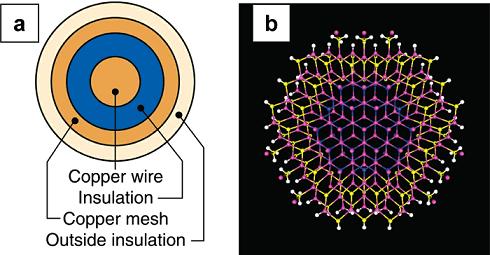Mining solar energy with coaxial nanowires
Scientists at the National Laboratory for Renewable Energy (NREL) and Lawrence Berkeley National Laboratory (NLBL) have designed a new type of nanowire - a kind of tiny coaxial cable that can deliver Great prospects for solar mining technologies (According to the new results published in the Journal of the American Chemical Society NanoLetters ).
The disadvantage of traditional semiconductors used as solar cells is when electrons receive light energy to jump to higher energy levels while creating holes, electrons and holes are usually in the same region, so they tend to reunite with each other. That feature is good for light-emitting semiconductor devices such as LED or LASER but not good for power generating devices like solar cells. A good solar cell is that it must effectively isolate electrons from holes in order to be able to use them to form an electric current.
"Our nanowires are designed to bring this characteristic, and they have better electrical conductivity," says NREL's Yong Zhang. "Both of these properties are key to improving the performance of solar devices."

Cross-section of nano cable (Photo: Nano Letters)
Their coaxial nanowires consist of a copper wire core wrapped around with conductive copper strips. Between copper core and copper strip is a layer of insulating material. Insulation has a role in preventing charges (electrons and holes) from meeting to recombine (figure).
Imitating this structure, the researchers designed a nano-sized version consisting of a core wire wrapped with a shell wrapped in hexagons. They use two semiconductor materials, GaN and GaP. There are two models, one with GaN core and the other with GaP, the other with GaP core and the shell is GaN. Both wires are about 4 nanometers in diameter. When GaN and GaP are combined into coaxial wires, they generate a new forbidden zone structure, which is different from the original forbidden zones. This new prohibition zone has proved very suitable for solar mining applications.
In addition to the insulating effect, this design can overcome some other features of solar cells. They can extend the absorption spectrum to sunlight and minimize energy loss due to electron-hole recombination.
"In addition to renewable energy mining applications, these nanowires can also be used in many areas from quantum computing to nano electronics."
- Fabrication of biological sensors from UNCD nanowires
- China decided to 'cut off' the Moon
- Most of the world's solar cells are installed in the wrong direction
- Technology to use solar energy at night
- Will people clean up gold in the Solar System soon?
- Clean energy future for Cuba
- Cuba built many solar parks
- Future solar batteries will be placed in the universe
- Solar cells have many advantages so why is not yet widely used?
- New technology allows solar cells to be more colorful
- Australia-US increased solar energy research
- Increase memory density with nanowires
 Daily use inventions come from universities
Daily use inventions come from universities Special weight loss device helps prevent appetite
Special weight loss device helps prevent appetite 8 inventors were killed by their own inventions
8 inventors were killed by their own inventions Iran invented a motor car powered by water
Iran invented a motor car powered by water Which planet is the largest in the Solar System?
Which planet is the largest in the Solar System?  The Sun goes into hibernation, will the Earth usher in a new ice age?
The Sun goes into hibernation, will the Earth usher in a new ice age?  263 extrasolar objects discovered, hinting at a mysterious belt outside the Kuiper Belt
263 extrasolar objects discovered, hinting at a mysterious belt outside the Kuiper Belt  Does the Solar System have 5 more planets similar to Earth?
Does the Solar System have 5 more planets similar to Earth?  Superstructure in space 'shades' Earth
Superstructure in space 'shades' Earth  US successfully transmits solar power from space to Earth
US successfully transmits solar power from space to Earth 